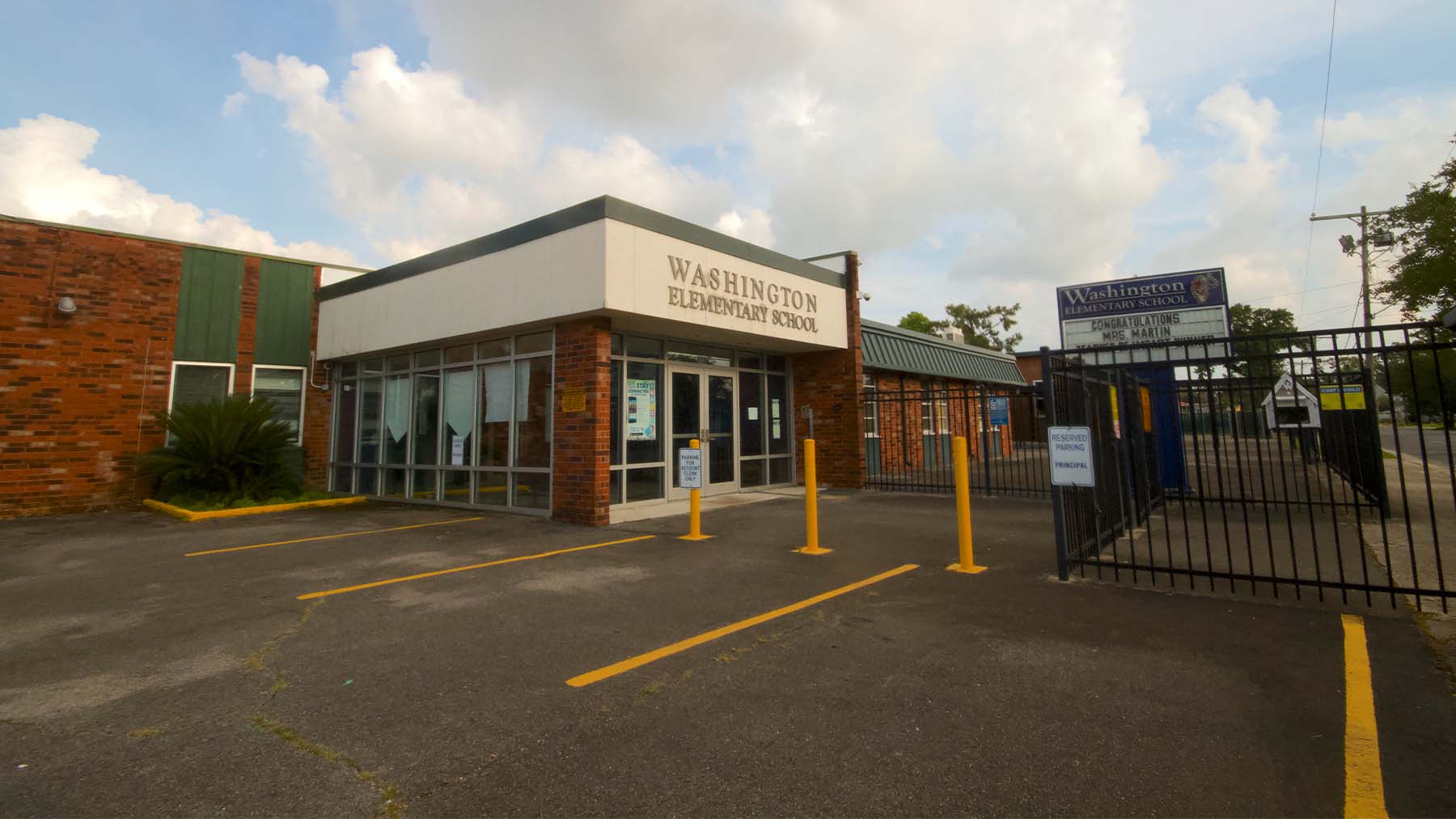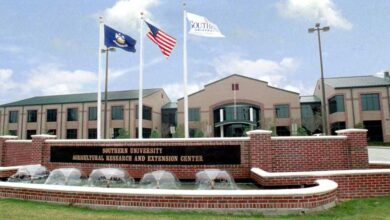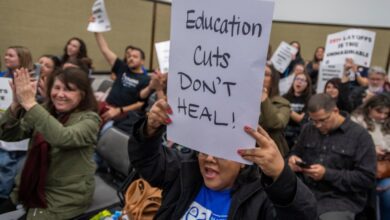Complaint details harm of Louisiana school closures

Content warning: This article describes incidents in which racist language was used.
There are at least six churches within three blocks of Washington Elementary School in Jefferson Parish, Louisiana, a community institution that has, since its dedication in 1936, started generations of Black and Brown children on their educational journeys. But the prayers coming from the predominantly Black and Latinx congregations to save the school may be in vain.
The majority-white school board that controls the school’s fate has had its say. Washington, along with five other schools, will be shuttered within months. The children who attend them will be bused to schools farther from their homes, separated from their friends, their communities and the support systems on which they rely. The largely white student body of another high school in the district will move into one of the high schools, while the school’s current diverse student population will be scattered.
Washington Elementary, founded by six Black fathers who bought the land to build a school for their children at the height of Jim Crow, is slated to be demolished. For a school that came to be only after white authorities refused to build a school in a Black neighborhood unless the community raised the funds itself, the wrecking ball will be a painful end.
It will also be another shameful chapter for a school district with a history of pervasive discrimination against students and families of color. Jefferson Parish, which straddles the east and west banks of the Mississippi River outside New Orleans, is the same place that in 1989 elected notorious white supremacist and longtime Ku Klux Klan leader David Duke to the Louisiana Legislature. At that time, it was a white enclave that grew when white parents left New Orleans after the schools desegregated in the 1970s. The same politics that elected Duke shaped the district’s school policies. Ordered by a federal judge to desegregate in 1971 – 17 years after Brown v. Board of Education – the district did little to comply over subsequent decades. It remained under the desegregation order until 2014.
In May, the Southern Poverty Law Center filed an administrative complaint with the Civil Rights Division of the U.S. Department of Justice (DOJ) that says, in effect, that racism in Jefferson Parish is a thing of the present, not just the past. The DOJ has since transferred the SPLC’s complaint to the U.S. Department of Education’s Office for Civil Rights.
“These school closures and the school board and local officials’ lack of responsiveness to concerns expressed by Black and Brown families are a crystallization of an ongoing legacy of discrimination that is sadly known to characterize Jefferson Parish,” said SPLC Senior Supervising Attorney Luz Lopez. “Schools that serve Black and Brown students are targeted as the first on the chopping block for closures. These are schools that, despite suffering in many cases decades of maintenance and resource neglect by the district, are foundations of the communities they serve. And yet, instead of listening to the voices of the community, instead of investing in the community, they are taking away their schools.”
Lopez pointed to the difference in the treatment of the white community after they expressed concern about the potential rezoning of the site where the now-shuttered Haynes Academy for Advanced Studies sits. The Jefferson Parish School Board and other local authorities ensured that white families felt heard, she said, funding a land use study and helping to establish a citizens’ advisory council that will determine the future use of the land in the predominantly white neighborhood.
“These Black and Brown communities could only hope to receive the attention and responsiveness that the school board and local officials showered upon the families of children who attended Haynes Academy,” Lopez said. “How can these school officials explain the difference in their regard for the voices of one set of parents over the other?”
Pervasive discrimination
The complaint seeks federal intervention to address pervasive and ongoing discrimination against students and families in Jefferson Parish School District, detailing failures to provide language access for emerging English speakers, racial and ethnic bullying and retaliation. The complaint cites concern over the treatment of Black students; emergent multilingual students and families; students with disabilities; and students experiencing homelessness in the district.
It follows another complaint filed two weeks earlier by the SPLC with the U.S. Department of Education’s Office for Civil Rights, urging the department to investigate the school board’s decision to move, consolidate and close a number of schools, including Washington, before the start of the 2023-24 school year. The complaint says the school closures will have a disproportionate and discriminatory impact on Black and Latinx students and communities in violation of Title VI of the 1964 Civil Rights Act, which prohibits racial discrimination.
The schools slated for closure serve a student body that is overwhelmingly Black and Latinx, affecting about 13% of students in the 47,000-student district.
School district officials say the closures and other changes are necessary to address declining districtwide enrollment, teacher shortages and rising insurance and repair costs for aging buildings. They say the changes will allow them to consolidate resources to better serve students across the board.
But while the school district faces undeniable challenges, the SPLC and other advocates continue to highlight its harm to Black and Brown communities.
Once majority-white, the 81-school district today is one of the most diverse in Louisiana; its enrollment is 34% Black, 37% Latinx and 22% white. The demographic transformation owes to several factors. Many Black families left New Orleans after Hurricane Katrina devastated city housing and infrastructure in 2005. Others left in search of better schools for their children. Meanwhile, the post-Katrina construction boom brought many new immigrants from Honduras and elsewhere in Latin America to the area to work. And as the racial makeup of the schools began to change, many white families moved their children into private schools.
The demographic transformation, however, has not been reflected in the makeup of the institutions that determine its policies. Seven members of the nine-member school board are white. All voted to shutter the schools in the diverse area on the east bank of the Mississippi. Only the board’s two Black members voted against the plan.
“This decision is shocking, and when you look at the composition of the school board, not surprising,” said Ashley Dalton, staff attorney with the SPLC’s Children’s Rights Practice Group. “[The school board] should be the voice of and the partners of the families, and they clearly are not. In a school district that serves over 60% of children of color, the board certainly does not look like the children and families they serve. And they certainly do not represent their interests.”
Hit like a hurricane
This is not the first time the SPLC has intervened in Jefferson Parish.
A federal civil rights complaint filed by the SPLC in 2012 on behalf of the district’s Latinx students resulted in a settlement agreement to address concerns over language access, bullying and retaliation. But the problems persist. A coalition of local advocacy groups, including Familias Unidas en Acción and the SPLC, has tracked numerous civil rights violations and incidents of discrimination since the start of the 2021-22 school year. The stories were shared with the DOJ under anonymity to prevent retaliation against students and families.
The American Civil Liberties Union of Louisiana, Step Up Louisiana, Rejoice Inc., Friends of Dandridge, and Supporters of Washington Inc. have all signed on to the most recent complaint.
The school closures not only adversely affect students of color. In some cases, they appear to openly benefit white students. For example, at Grace King High School, which closed in May, the student population was 64% Latinx and 38% limited English proficient. Under the district’s plan, the student body will be required to disperse and attend two different schools, while students from Haynes Academy, which is primarily white, will take over the Grace King High School building. There are no students with limited English proficiency enrolled at Haynes Academy.
The district plan hit this community like the hurricanes for which the region is known. While the district had commissioned a study of changes, including school closures and rezoning, in 2018, it had been put on hold during the pandemic. In January, the school commissioned a new study. On March 27 it made public its recommendations and announced a hearing and vote on the proposals for April 5. That gave parents, students, alumni and other community members just 10 days to mobilize.
Unrelenting racism
Despite the abbreviated timeframe, hundreds did mobilize. The hearing lasted almost three hours, with scores of parents there to speak out.
Many spoke passionately of the difficulties their children would face being suddenly uprooted from their schools. Older students would be cut off from their friends, their sports teams, the schools they identified with. Students from families without cars or with parents who work full time would be unable to get to and from extracurricular activities in schools far from their homes. More ominously, some parents said their high school students have received threats, saying they will be unwelcome, from students at the rival schools they are slated to attend in the fall.
Some parents described racism they called unrelenting.
Dawn Jarrell moved to the district with her husband and children 12 years ago from New Orleans to seek a safer environment and better schools, she said, after her sister was killed by a police officer. Now she takes care of her sister’s children along with their own, she said.
Her youngest, 15, is finishing her sophomore year at Haynes Academy. According to a complaint filed with the district by Jarrell, she has been called “ghetto Black girl” and the N-word by white students. During Black History Month this year, according to the complaint, Jarrell’s daughter and other Black students were harassed on the Snapchat app by photos posted of them accompanied by racist captions.
Jarrell said the district has said it is investigating the incidents and that school administrators, initially slow to act, are now promising to institute policy changes to discourage such incidents. But the impact on her daughter, she said, has been profound.
“We literally moved so our children could go to A-rated schools, and yes, I expected some racism because, at the end of the day, this parish is traditionally racist,” Jarrell said. “But we couldn’t have expected anything like this. The older she got, the worse it got. And at the end of the day, unfortunately, with the state of the education system right now, there are no better options. … We’re going to continue to push for policy change in relation to racism and bullying.”
‘Doesn’t make sense’
Babette Nagel, the parent of two students with severe autism who attend one of the schools affected by the plan, said her sons have been screaming and hitting themselves since news broke of the closures, fearful of the sudden change. Unlike the school they currently attend, the school they are required to attend in the fall does not have facilities compliant with the Americans with Disabilities Act. School district officials say improvements will be instituted by August.
“So, we are going to have to just hope and pray that they have all the supports in place? How can we, when it seems like nobody really cares?” Nagel said. “This is earth-shattering for my sons, catastrophic. And nobody has called me. Nobody has reached out to me.”
Another parent, Rana Ottallah, said it is hard to believe the school plan will help all students.
“It’s hard to buy these arguments if the only impact is on students and families that are Black and Brown families,” Ottallah said. “If you want to make a change that benefits the whole district, then everybody should benefit from the change. But to see that certain populations are impacted, and other populations are spared, it doesn’t add up, it doesn’t make sense.”
Margie Loud Zeno retired as the executive director for human resources for Jefferson Parish schools in 2000, after a career as an educator, speech pathologist and audiologist for the district. She says she is sympathetic to the need for the school district to study how best to use its facilities, and to address declining enrollments and the challenge of a shortage of teachers. But she said that enrollment is not declining primarily in the areas where many of the schools are being closed.
“For years you have had what I would call benign neglect of schools in Black and Brown communities,” Zeno said. “Now you have closures of these schools that certainly look like they are targeting Black and Brown kids disproportionately.”
Highlighting that neglect, in June a fire broke out at Washington Elementary, causing extensive damage to the school’s gymnasium. Fire investigators said the blaze was likely caused by a faulty lighting fixture.
‘Brings tears to my eyes’
As community members continue to grapple with the impact of the school closures, local church leaders have gotten involved.
In May, the Rev. Kaseem Short, pastor of Thomas United Methodist Church, at the heart of the community which will be affected by the closures, led a prayer service outside Washington Elementary. At his side was Debra Houston Edwards, chair of a group called Supporters of Washington Elementary STEM School. A former preschool coordinator for the school district, she is the granddaughter of one of the men who founded the elementary school. According to Edwards, until then there was no school serving what was then an almost entirely Black area.
In 1934, after the men petitioned school authorities, the school board demanded the Black community purchase the land itself and pay a significant amount of the cost to build it. They did, and for decades the school served Black students from kindergarten through 12th grade.
Most recently, the school thrived with a curriculum focusing on science, technology, engineering and mathematics (STEM), Edwards said.
“I’m so filled with emotions and so hurt, devastated by what they’re doing,” Edwards said. “I am speaking on behalf of the community, on behalf of the faculty, speaking on behalf of the parents who feel they have no hope, speaking on behalf of the legacy and the history of Washington, where our ancestors worked and toiled to make a school for Black children possible. It brings tears to my eyes. We want to save it for what it can do for our children.”
Photo at top: Washington Elementary School, founded by six Black fathers who bought the land in Jefferson Parish, Louisiana, to build a school for their children at the height of Jim Crow, is slated to be demolished. (Credit: Dwayne Fatherree)




